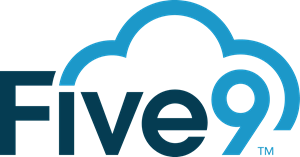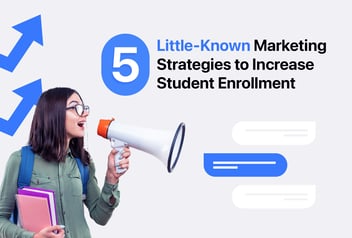How to Increase Student Enrollment in University Using AI

Many institutions today are struggling with the challenge of attracting and retaining prospective students. Picture an eager high schooler scrolling through a potential university only to be bombarded by generic text message blasts offering little to no real value.
Traditional methods simply fall short in an era where personalization reigns supreme. The key to success lies in embracing modernized, tailored approaches that cater to each student's unique needs and preferences.
That said, modern solutions are now available. Considering factors that influence enrollment and adopting the power of artificial intelligence (AI) can help institutions achieve sustainability.
Join us as we delve into what drives student enrollment growth. If you haven't yet, it's high time you revamp the student experience for the better.
Let’s get started.
Factors and Challenges that Affect Student Enrollment Growth
We've seen a slow and steady rise in student enrollment in recent years, but we're not quite at the peak of our potential just yet.
So, what's holding us back? Here's the scoop on the factors that are impacting student enrollment growth and the common challenges that come along with them.
Accessibility and Affordability
The rising cost of tuition and the fear of student debt deter potential students, putting pressure on both institutions and families. Unfortunately, around 78% of households even said that they excluded a university from their list of potential options because of financial constraints.
The pandemic also had a devastating impact on the education sector. Compared to a decade ago, undergraduate enrollment declined 15% in fall 2021, with 42% of that decline occurring during the pandemic itself.
Financial aid options, scholarships, and flexible payment plans can mitigate these barriers, but institutions must be able to balance revenue growth with affordability concerns.
Onboarding Experience

First impressions matter. This makes the enrollment process a defining moment in the school experience. From the ease of application to the level of support provided, every interaction shapes a student's perception of the institution.
A seamless, positive onboarding experience retains students, while recruitment strategies are necessary to increase enrollment figures. Balancing increased enrollment with maintaining high-quality academic standards and student support services encourages them to remain enrolled and successfully complete their studies.
School Reputation and Facing Competition
Reputation matters. Effective marketing strategies shape the institution's perception and attract prospective students. However, in a highly competitive environment, institutions must also stand out with a clear value proposition and targeted marketing efforts.
Changes in population demographics, including birth rates, immigration patterns, and socioeconomic shifts, can also directly impact enrollment trends. A good reputation can be built through word-of-mouth, rankings, inclusivity, and alumni success stories.
Campus Environment
The location and campus environment impact enrollment decisions. Consider factors like proximity to urban centers, campus amenities, housing options, and campus safety. Universities in desirable locations with a vibrant cultural scene may also have a competitive edge.
Increasing enrollment also requires institutions to upgrade their technology infrastructure. Meanwhile, creating a healthy campus environment calls for intentional efforts to foster diversity and inclusion.
Adopting a growth mindset enables individuals to confront internal biases and embrace continuous learning. Unlike a fixed mindset, which perceives qualities as permanent, a growth mindset promotes openness to change and growth.
Employment Opportunities
Students increasingly want to be sure that their education investment pays off with real job opportunities and financial stability after graduation.
While there's a common assumption that more education equals better job prospects, that's not always the case. Interestingly, around 16% of American high school graduates actually earn more than many college degree holders.
Schools providing strong career services, internships, and industry partnerships attract students seeking practical skills and job prospects. Addressing these factors directly helps institutions secure sustainable enrollment growth amidst fierce competition.
The Answer is AI

With the rapid advancement of technology, universities are adopting an AI system to streamline student recruitment and enrollment processes.
AI integration into enrollment Customer Relationship Management (CRM) systems paves the way for more personalized and efficient student engagement. Institutions can now collect, store, synthesize, and analyze data in new and innovative ways to support student recruitment and academic success.
Enter AI texting—an automated solution that streamlines communication processes. Conversational AI, powered by sophisticated algorithms, translates a wide range of vocabularies and communication styles well.
Here are the biggest benefits of having a powerful AI texting platform in your system:
- Revive Aged Inquiries: Automate engagement with aged leads in your database using AI texting platforms. Prioritize and categorize these leads for targeted follow-up messages, reigniting their interest in your programs.
- Send Messages with Ease: AI texting platforms deliver prompt, natural, and customized communication, addressing message deliverability and timeliness challenges.
- Digital Assistance at Your Fingertips: Integrate a digital assistant into your AI platform to automate call scheduling and reduce wait times. Seamlessly connect students with human representatives, maximizing conversion potential for aging inquiries.
With an AI texting platform, students will be able to enroll conveniently and succeed at your institution.
5 Ways to Increase Student Enrollment in University Using AI Texting
While manual texting might suffice for individual conversations, handling large volumes of inbound messages is a whole different ball game.
An AI texting platform for education can handle the heavy lifting, freeing up your team to focus on their core responsibilities without the hassle of manual responses or missed messages. But there are also more exciting things this tool could do.
1) Be the First to Connect

There might be a student out there who wants to reach out but is hesitant to do so. Being the first to connect with prospective students can significantly increase the likelihood of higher enrollment rates.
With the use of AI texting, universities can improve their contact success rates, especially considering that many people are hesitant to answer calls immediately.
The initial text you send first serves as a gentle nudge toward a deeper interaction. It offers the opportunity to schedule an enrollment interview with an advisor.
While texting doesn't replace other communication methods, this approach grants students more control over their engagement, allowing them to choose how they respond—whether it's by answering the phone, returning a voicemail, or using texting to arrange a convenient time.
2) Cut Down on Calls and Emails
Reducing the reliance on calls and emails can significantly enhance the chances of increasing student enrollment. Every day, institutions get tons of emails and handle lots of calls, so it's inevitable some inquiries will get lost in the shuffle.
Even though a student's inquiry about payment details or enrollment dates may seem simple, when multiplied across thousands of other students, it can overwhelm staff and hinder enrollment and retention efforts. This results in a poor student experience.
AI texting offers a solution by efficiently addressing routine questions in large volumes. This relieves your staff of mundane, time-consuming tasks while still meeting student needs. With the help of an AI texting platform, students gain the ability to access information independently at their convenience.
The time saved from adopting AI technology allows more people to focus on more in-depth interactions with students, ultimately improving overall efficiency and the quality of student support services.
3) Be available 24/7

Being available round-the-clock improves enrollment chances. Inquiries sometimes come in overnight, particularly for popular programs with high demand. Before automation, enrollment staff would regularly face a backlog of prospective students waiting for initial contact each morning.
However, with AI texting, students receive customized messages almost instantly after sending their inquiries. Depending on the sophistication of the SMS solution, the software may even offer specific time slots and assist students in scheduling a first call, meeting their needs promptly.
This not only satisfies students' expectations for instant answers but also allows your staff to allocate more time to meaningful advising rather than transactional communication.
As it interacts with users, AI also learns and becomes more adept at handling complex inquiries and situations over time, further improving student satisfaction and enrollment outcomes.
4) Help Students Make The Right Choice

Speaking of handling more complicated inquiries and situations over time, you can utilize AI texting to help students make their career decisions. Just like many of us in our younger years, many students face uncertainty when selecting courses.
A number of factors can contribute to this, such as academic interests, budget constraints, and potential career prospects. Institutions can utilize AI texting to attract and engage students interested in their offerings.
AI can direct students and give them detailed information about the courses they are considering, including media like explainer videos and other online resources. Using well-designed interaction flows, an AI texting platform can point students toward their interests, ultimately increasing course registrations and university admissions.
5) Automate Event Management

An automated texting service can automate event management processes, such as scheduling, reminders, and follow-ups for recruitment events, open houses, and information sessions.
AI systems can also provide instant event-related information and assistance, such as event details, directions, and FAQs, further enhancing the attendee experience and increasing the likelihood of enrollment.
This automation streamlines event coordination, reduces administrative burdens, and ensures that recruitment events are effectively utilized as opportunities to attract and enroll prospective students.
5) Streamline Document Collection

AI texting platforms can streamline the document collection process by automating reminders, notifications, and follow-ups for required application materials, such as transcripts, letters of recommendation, and application forms.
Through text message prompts and reminders, institutions can ensure that prospective students submit all necessary documents in a timely manner, reducing delays in the admissions process and expediting enrollment.
Automation improves efficiency, improves data accuracy, and makes application processing seamless for applicants, which leads to higher enrollment rates.
Integration with Other Systems
AI texting platforms are easy to integrate with other enrollment management systems, including CRM software, student information systems, marketing automation platforms, and document management systems.
Through data synchronization across multiple systems, institutions can guarantee uniformity in messaging, monitor student interactions, and automate workflows like enrollment status updates and tailored communications.
This integration promotes department collaboration, supports data-informed decision-making, and offers a comprehensive understanding of the enrollment process.
Make AI Your Competitive Advantage
Leveraging AI can give your institution a competitive edge, especially against competitors who haven't adopted these technologies. Beyond the enrollment process, the implementation of AI tools can enhance students' academic studies and campus life.
Automated solutions, powered by AI and machine learning, are transforming how students learn and engage with information. Universities can now offer personalized learning experiences, with AI enabling faculties to deliver instruction and support to students more efficiently.
AI tools can address student queries in real-time, facilitate faster learning, and provide interactive feedback. This holistic integration of AI not only improves learning outcomes but also enhances the overall student experience, making your institution a highly desirable prospect for students.
In Conclusion
Leveraging AI systems in student enrollment processes opens up a world of possibilities for educational institutions. AI texting platforms, for instance, offer valuable solutions to enhance the enrollment experience for both students and staff.
Embracing innovative strategies and AI tools will not only increase enrollment rates, but will also improve efficiency, collaboration, and student success. It's clear that AI continues to be a powerful ally in driving success and innovation in student recruitment and enrollment.
So, embrace the future of enrollment with AI technology and pave the way for a brighter, more accessible, and inclusive educational experience for everyone.
A programmer by trade, Nick Saraev is a freelance writer and entrepreneur with a penchant for helping people achieve their business goals. He's been featured on Popular Mechanics & and Apple News and has founded several successful companies in e-commerce, marketing, and artificial intelligence. When he's not working on his latest project, you can find him hiking or painting.


.png?width=512&height=512&name=guru%20(1).png)

.png?width=199&height=109&name=salesforce-logo1-removebg-preview%20(1).png)


.webp?width=716&height=569&name=banner-img%20(1).webp)


.png?width=352&name=aysfh89oda%20(1).png)
.png?width=352&name=asdfhjsd%20(1).png)